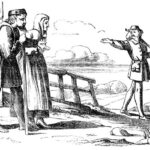“If children do not have space to release a tremendous amount of energy when they need to, they will drive themselves and everybody else in the family up the wall.” Christopher Alexander, A Pattern Language
We need spaces that foster the various aspects of human life. This applies especially to children.
Some spaces–such as the family room or the kitchen–allow us to enact our unity as a family: our lives are so intertwined that we cannot be whole without one another. Here our children experience that they belong somewhere, because here they live one life with us.
But at the same time we each have our own lives. And the spaces of our home should reflect this too.
Our children need a space that empowers them, indeed invites them to use some of their prodigious energy and creativity in relative isolation from adults. Precisely because such activities do not have a place in the other spaces of our home, it is incumbent upon us to prepare a special space for them.
If at some times—and there are a few—children should be seen and not heard, then likewise there are times, and thus places, where their boisterous activity should proceed unencumbered, with no detriment to the activities or peace of others. This is a delicate balance. Given that we rightly expect at times our children to conform themselves to the standards and sensibilities of adult activities, we actually bolster this effort by also allowing the wholesome release of energy in a space fitted for their physical and psychic inclinations.
A world where fewer and fewer spaces are truly safe and friendly for children calls us to be more intentional in preparing the spaces of our home, guided by an understanding of children’s true needs.
Alexander’s further thoughts:
“Start by placing the small area which will belong entirely to children—the cluster of their beds. Place it in a separate position toward the back of the house, and in such a way that a continuous playspace can be made from this cluster to the street, almost like a wide swath inside the house, muddy, toys strewn along the way, touching those family room which children need—the bathroom and the kitchen most of all—passing the common area along one side (but leaving quiet sitting areas and the couple’s realm entirely separate and inviolate), reaching out to the street, either through its own door or through the entrance room, and ending in an outdoor room, connected to the street, and sheltered, and large enough so that the children can play in it when it rains, yet still be indoors.” Pp. 654-55
Cuddeback comment: This prescription from Alexander is perhaps impractical in a number of its details given the already existing structure of our house. What strikes me is the principle, which we might still apply in arranging or disposing already existing spaces. Children should be made comfortable in pursuing active play in congenial indoor space, always with an eye to being connected to the great outdoors. Among other things, such spaces can be conducive to active engagement with people and the world, as opposed to passive entertainment.
This is the fourth of a series taking a thoughtful tour through a house, room by room, based on the writings of Christopher Alexander.
Christopher Alexander (born 1936) was born in Austria and is currently an emeritus professor of architecture at the University of California, where he taught for almost forty years. He has been widely influential through his theories of architecture, and is especially known for his 1977 book A Pattern Language.
Image: Ludwig Knaus (1829-1910), Ein Kinderfest
Originally posted at Bacon from Acorns





